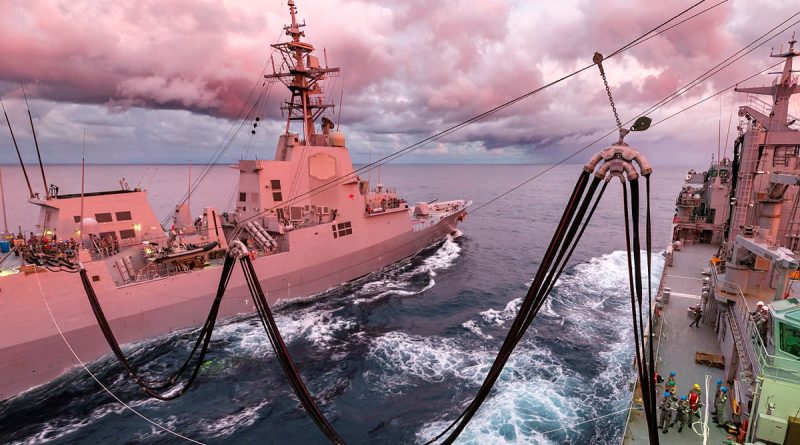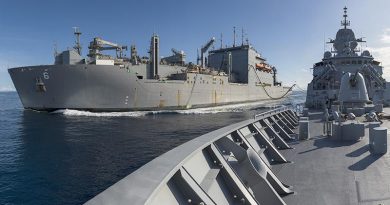Supply critical to keeping ships at sea

It is crucial for ships to be at sea and just as important to keep them there.
CAPTION: HMAS Supply conducts a replenishment at sea with HMAS Sydney, off the east coast of Australia. Story by Lieutenant Yvette Goldberg. Photo by Able Seaman Jarryd Capper.
Replenishment ship HMAS Supply is one of Navy’s key enablers for keeping the fleet in the fight.
Supply carries fuel, water, food, dry cargo, ammunition, equipment and spare parts to provide operational support to other ships or combat forces based far from ports for extended periods.
Completing successful replenishments at sea (RAS) in varying weather conditions showcases Navy’s capabilities in refuelling and resupplying at sea, which is critical to extending time at sea for other ships.
Supply’s navigation officer Lieutenant Jackie Rushford said the successful completion of a RAS was a strong indicator of the auxiliary oiler replenishment ship’s criticality and versatility.
“Supply’s key role in exercises and operations is as a combat support ship – when we operate as a task group, to keep the task group in the fight, we need fuel, we need stores and we need to be able to keep the ships at sea for as long as possible,” Lieutenant Rushford said.
“We will often come together the day before and walk through the evolution. Any specific requirements the ship may encounter are discussed – the key is preparation.
“The relationship between Supply and the other ships is crucial – we can’t do our job without them and they can’t do their job without us.”
A RAS involves Supply’s various departments working together.
Both technical and non-technical expertise are required for the transfer of fuel, water and solid cargo to other ships while both ships are underway.

CAPTION: Able Seaman Charlotte Collins from HMAS Supply keeps lookout as HMAS Parramatta prepares to conduct a replenishment at sea off Australia’s east coast. Photo by Able Seaman Jarryd Capper.
Lieutenant Jackie Rushford said Supply’s crew engaged with other ships frequently to find out when they needed to be resupplied to ensure Supply could provide supplies in a timely manner.
“In a RAS, there are a lot of moving parts – a lot of things need to happen and come together for it to be successful,” Lieutenant Rushford said.
“The way we do it on Supply is through regular communication and planning as well as pre-briefing all of the things we need to do.
“On the day, it really comes down to people’s experience and knowledge – that’s the way we build together to make sure the replenishment goes as well as possible.”
Leading Seaman Percy Traill said there were many people involved in a RAS.
“The boatswains in the dump party on deck are controlling ropes and lighter duties,” Leading Seaman Traill said.
“My current job is in the RAS hut controlling the probe across to the other ship.
“I have also been trained to work aft of the ship. This is the secondary RAS control option for Supply.”
Leading Seaman Traill said a highlight of completing a RAS was seeing the look on everyone’s faces.
“It’s great knowing that the job was completed safely and it was so well done,” he said.
“My job is awesome. Sitting in the RAS hut controlling the probe to the other ship gives me this big responsibly. That feels really cool and I love doing it.”
.
.

.
.





![A 1RAR soldier dismounts a Bushmaster equipped with a protected weapon station [or system? – let me know ASAP if I'm wrong] (PWS) to fire the 84mm rocket launcher. Photo by Corporal Jamie Osborne.](https://www.contactairlandandsea.com/wp-content/uploads/2016/12/pws-390x205.jpg)